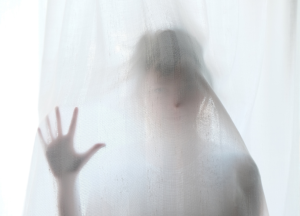Do you like being trapped in a small space? How about in a small space in an unfriendly dimension? If so, this month’s post is for you!
I’ve decided to try something experimental to teach you about the wonders of the Elevator Game–a try-at-your-own-risk, internet “ritual” that was born cerca 2008 and has seen an uptick in the past couple of years.
The goal of the game is to get to another dimension, and then (of course) to get home. All you need to play is:
- Yourself (you must play alone),
- A 10+ story building with an elevator that services at least 10 floors, and
- To follow the “rules” of the game. These include pressing the floor numbers in a specific sequence, among other things.
Let’s play here live. Instead of reading this post in order, press the button at the end of each section to travel to the next floor in the sequence.
As we go, we’ll discuss what you can expect to happen, and outline any of those other pesky “rules” that might be helpful for staying alive.
Sound good? Scroll down to start on the first floor.
Floor 1
Here we are! You can start the Elevator Game at any time of the day, but you must start the game on the first floor. You must only call the elevator using the “up” button. And, to reiterate, you must be alone.
Before you step in, take a long moment to familiarize yourself with the lobby around you. How many lights does it have? What is the exact pattern along its walls? What does it smell like? How do shoes sound scuffed against its floors? It will be important that you remember every detail later. Maybe life-or-death important.
Now, let’s step inside. Once you’re in, do not get off the elevator at any point until we reach our destination or until you return safely to this lobby. Got it?
Going up!
Floor 1
Back at the lobby at last! Thank god. Only…are you sure it’s your lobby? Take a look around. Take a listen around. A smell around. Is anything…off? No? Are you sure?
Remember how I told you to pay attention when you got on? Just because you’ve exited the ritual doesn’t mean that you’re back where you belong. So…are you sure? Because once you step off the elevator, that’s it.
If you’re not sure, you’re going to need to start the ritual all over again, completing the sequence again and again until you are.
Also–you’re still remembering not to acknowledge the woman, right? Even though she’s getting a little closer?
Floor 2
A few fun elevator music facts:
- “Muzak” is an official brand name, not unlike Kleenex or Chapstick
- 7-Eleven weaponized it in the early 90’s to deter teenagers from loitering around their stores
- The tunes are deliberately calibrated to hack into your brain and manipulate your emotions. Its inventors found it especially helpful, for example, to lull people into a sense of docility as they hurtle hundreds of feet through the air in a small metal box.
Going up!
Floor 2
At this point, you may hear someone scream your name. Not to worry. It’s time to go to floor 10, our ultimate destination, for the first time. We’re not in the other world quite yet, but I assure you: we’re close.
Floor 3
Good choice. Though that woman’s laughter is going to stick with you for a long time, isn’t it?
Hit 1 to go to the first floor and get the sweet hell out of here. What’s that? It’s not working? Hit it again. Again!!
Floor 4
Enjoy the elevator ride and this little box you’re trapped in. Claustrophobia impacts about 12.5% of adults at some point; fortunately, it doesn’t impact you. You don’t mind that you can’t stretch your arms out without hitting either wall. Nor that if this box was airtight, you’d run out of oxygen in less than 2 days.
Also: You’re still alone, right? You have to be alone this entire time, until the moment when you’re not.
Going down!
Floor 5
When the doors open on 5, a woman might get on.
If she does, do not look at, speak to, or acknowledge her in any way. Even if she looks like someone you know. Especially if she looks like someone you know.
She may try to get you to break the rules. She’ll say that there’s been an accident and ask for your help. Or she might scream obscenities into your ear. Or she might simply stand in silence, staring until the urge to look at her becomes almost unbearable.
Don’t do it. Do not so much as glance at her feet.
Now is the moment of truth. You’re going to press floor 1. Only, if the ritual has worked, the elevator isn’t going to go to floor 1. It’s going to floor 10.
She’s watching you. Press the button.
Floor 6
Did you know that incidents involving elevators and escalators kill about 30 and seriously injure about 17,000 people in the U.S. each year? Elevators specifically cause almost 90% of the deaths and 60% of the injuries.
Passenger elevator deaths were categorized as follows:
- Falls (60%)
- Caught in/between (21%)
- Other (19%)
“Other,” you say? “Other” meaning what?
Going down!
Going up…
Can you feel your stomach jump? It’s working! Are you really sure you want to do this, though? I haven’t mentioned yet what’s on floor 10.
If you hit any button other than 1 or 10 before you reach the 9th floor, you can still back out. In fact, I will go so far as to recommend that you back out, since the other thing I haven’t mentioned is that it’s a little unclear if you can ever really come back after visiting floor 10.
We’re passing 8 now…what’s it going to be?
Floor 10
You will see floor 10 now as it is in our world: ordinary enough. Maybe a little quieter than you would like it. And your blood might be pumping a little faster now, because we’re about to get to the part of the game that people really, really don’t like.
Ready?
(Floor 10)
The elevator doors slide open into darkness. The 10th floor is completely deserted. Other than that and the fact that all the lights are off, it looks almost normal.
Well, you’ve gotten this far, haven’t you? Why don’t you get off?
“Where are you going?” asks the woman. Or maybe she shrieks as your feet cross the threshold. She’s prone to do either–she’s wily that way. You’ve remembered not to jump and look at her right? Even though it’s just you and her here, alone in the dark?
That loneliness is a sign that you’ve made it. This other world is many things, but it’s not populated. As you move down the hall past tightly shut doors, you realize that your cell phone and watch are no longer working. That’s too bad, because at this point, you are really craving some light.
Hold on–there’s light there, coming through the window. It’s red–a searing red, but not a red that’s warm. It’s–well, it’s coming from a cross. A blazing red cross, glowing way off in the distance.
Except wait: There’s a red cross down the hall now, too, bright in the black. Or was that where you saw it originally? Has it been there all along? It’s closer than the other one. A lot closer.
What’s that? You want to go home? Well, better get back to the elevator, then. Only…which elevator was it? It’s important that you take the same one. Do you remember the one that you took? I can see you’re a little dizzy. Maybe a lot dizzy. Well, hurry back. You’re going to have to execute the ritual in reverse, if you ever want to get home. The hall is tilting merrily, but I’m sure you’ll find the elevator before you pass out.
(Don’t pass out, by the way. If you do, you’ll never get home.)
See you’re back in the elevator now! Well, an elevator. The woman is there waiting for you, but I get the feeling that she might be waiting in every elevator, don’t you? I think she might be smiling. But don’t look! Execute the ritual in reverse now, go on.
What’s that? You don’t remember the numbers? I didn’t tell you to write them down? Oh. Sorry about that. I know the room is spinning and all, and there’s a pretty heavy ringing in your ears, but I’m sure you can figure it out. Go on. Press the right button, just as soon as it holds still.
Home at last!
Only–are you? You were supposed to move laterally, not upward, right? Oh, well. I’m sure it’s no big deal. When you go to sleep tonight, I’m sure you’ll wake up in your own bed, and not in the hallway on the 10th floor.
Maybe I should have given you more detailed instructions for this game right from the top. Or been a little more clear that people who have played this game often don’t end up in the greatest of places, even if they seem to have made it out.
You see, even if you think you’ve played the game right, if you break a single rule, you’ll end up in a world that seems like yours, but is not. A world that will turn on you by degrees. Many report a feeling of being followed, of seeing and hearing strange sounds, of developing a slow, uncontrollable shake. And if they’ve gone and looked at the lady from 5–whew. God help them. They’ll continue to look at her for the rest of whatever remains of their lives. They’ll spot her in a busy crowd. On their street. Outside their window.
But that’s not you. You followed all the instructions to a T; you never looked at or acknowledged that woman with the brown hair and polka dot dress and blue eyes that struck you right in your guts, and, if you visited the 10th floor, you flawlessly executed the trip in reverse (1-6-5-10-2-4-1. Or was it 1-4-2-5-10-6-1? 1-5-10-4-6-2-1?). Right?
Right.
What do you think–was it worth it? Or next time, are you taking the stairs? Share your thoughts in the comments below.
IMAGE CRED: Derrick Treadwell of Unsplash. Thank you very much!































You must be logged in to post a comment.